Amazon recently announced that its largest sale event, “Prime Day,” will go live at midnight on Oct. 13, with deals lasting 48 hours. For shoppers, the sales and low prices may be appealing, but the day itself is a grim reminder of just how dangerous Amazon and its growing monopoly can be.
In less than 25 years, the company went from a small website offering books to a monster e-commerce site that surpasses sales at all of America’s department stores, grocery stores and restaurant chains combined. Amazon accounts for almost half of all e-commerce sales, far surpassing Walmart (23%) and Target (19%). Additionally, the company is valued at over $1.5 trillion—more than Florida’s entire 2019 GDP.
This domination is stifling and raises concerns about whether it violates antitrust laws, which were put in place to protect consumers from inflating prices. Many independent retailers, retail chains and government officials now fear that Amazon might take over the entire market, a term called total market dominance, and then charge whatever sort of prices it wants.
We’ve seen this happen before. In the early 1900s, Standard Oil owned or operated 90% of the nation’s oil refining business, and many at the time believed it was corrupting politicians and laying waste to competitors. The Supreme Court eventually ruled that the company should be broken up into smaller operations to prevent one single player from dominating the market and setting prices that might harm consumers.
Amazon is increasingly a vertically integrated company. This means it doesn’t just sell other companies’ products — like Johnson & Johnson baby soap or Michael Kors shoes; it makes and sells stuff of its own. This is tough for competitors because Amazon has the ability to see what goods are selling well and then swoop in and start selling those goods itself.
Researchers at Columbia University note that vertical integration can harm consumers and reduce economic efficiency, insulating some operations from competition. It’s the perfect perch from which Amazon can dominate anyone that’s competing against it.
And the company is expanding. It is moving into the financial and health care sectors.
After Amazon’s acquisition of a billion-dollar pharmacy business called PillPak two years ago, Walgreens, CVS and Rite-Aid lost about $11 billion in value overnight, according to The Wall Street Journal. Barron’s magazine reported that Amazon’s move into the entertainment business, especially with Prime Video, has a negative impact on traditional TV providers and Hollywood studios, increasing the cost of obtaining intellectual property and creative talent.
But we all enjoy the convenience of Amazon, especially amid the pandemic. So is this really that big of a deal?
Yes. Extreme market dominance can lead to a monopoly and abuse of power. Think of it as a bully who runs the schoolyard and others can’t defend themselves. And the more the bully, or the company, grows largely unchecked, the greater the risk becomes. Amazon’s growing monopoly could wipe out retail jobs and stifle competitors. And, the fewer competitors there are, the more autonomy Amazon gets to control prices. The company is on track to have a domination that we go to for everything — furniture, clothes, food, medication, etc.
Amazon knows who we are — and what we buy, how often we buy it and what we’ll want to buy next. It continues to grow, and Jeff Bezos (whose net worth is now $150 billion) becomes more powerful. Heading into Prime Day, more of us ought to think twice about whether saving two bucks on a new blender from Amazon is really worth it. Or, if paying more and buying local — from a store owned locally — is a better value.
Annika Olson is the assistant director of policy research at the Institute for Urban Policy Research and Analysis at The University of Texas at Austin.
A version of this op-ed appeared in the Austin American-Statesman, Lubbock Avalanche Journal, Brownwood Bulletin, Alice Echo News Journal and the Nueces Country Record Star.




